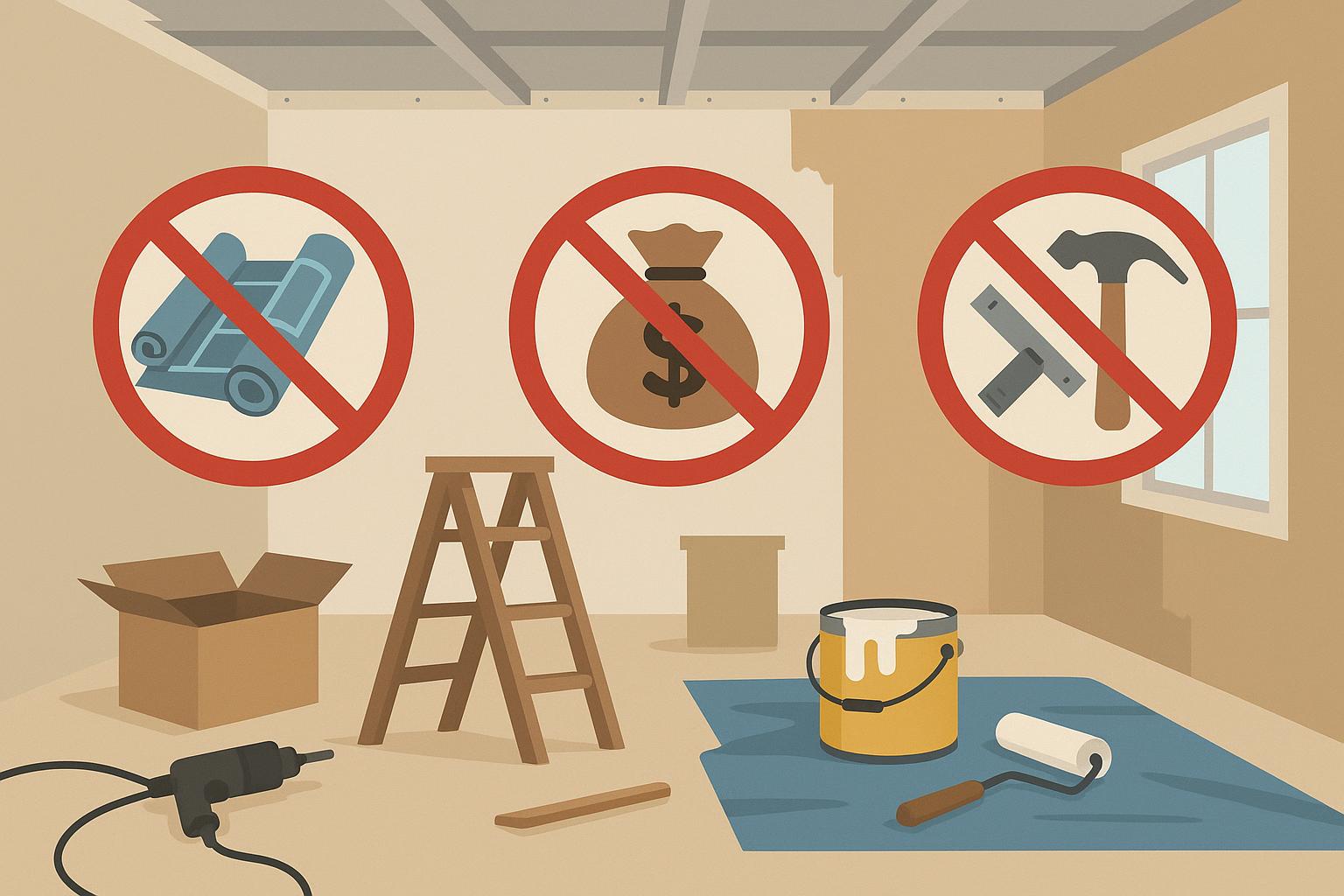Most homeowners dream of a successful renovation that enhances both functionality and aesthetics. However, you can easily derail your project by making common mistakes that lead to delays and increased costs. From poor planning to neglecting permits, it’s vital to be informed about potential pitfalls. In this post, you’ll discover key errors to avoid, ensuring your renovation journey is as smooth and efficient as possible. With the right insights, you can turn your vision into reality without the unnecessary headaches that can come with home improvement projects.
Common Planning Mistakes
To ensure your home renovation goes smoothly, it’s important to avoid common planning mistakes that can lead to frustration and additional costs. A well-thought-out plan will help you navigate the complexities of your project, allowing you to stay on track and achieve your vision without unnecessary stress.
Inadequate Budgeting
The largest pitfall in planning a renovation is often inadequate budgeting. Many homeowners underestimate the costs involved, leading to financial strain and project delays. It’s important to account for not just materials and labor, but also unexpected expenses that may arise during the renovation process. Building a buffer in your budget will help you manage these surprises more effectively.
Not Defining Priorities
Defining your priorities before starting a renovation project is vital to ensure that you spend your time and money wisely. Without a clear understanding of what aspects of your renovation are most important to you, you may find yourself making hasty decisions that could derail your plans or waste resources.
Planning your renovation effectively means identifying what you want to achieve and which features are non-negotiable versus those that are flexible. Spend time evaluating your needs and desires as well as how each element aligns with your overall goals. This focused approach will guide your decisions, keeping you aligned with your vision throughout the process at Coastal Cabana.
Underestimating Project Timelines
One of the most common mistakes in home renovation is underestimating project timelines. When you plan your renovation, it’s easy to think everything will go smoothly and according to schedule. However, it’s important to account for potential delays, including unexpected complications or material shortages. By accurately assessing the time required for each phase of your project, you can set realistic expectations and avoid frustration down the line.
Overlooking Permits and Approvals
Behind every successful renovation lies a set of permits and approvals that are often overlooked. You must check local regulations to ensure your project complies with zoning laws and safety codes. Failing to secure the necessary permits can lead to costly fines and even halting your project. Always consult with local authorities or professionals to ensure you’re covered before breaking ground.
Ignoring Weather Delays
Approvals aside, you also need to be mindful of weather conditions that can affect your renovation timeline. Bad weather can disrupt outdoor work, leading to unforeseen delays in your project. Therefore, it’s wise to incorporate some buffer time into your schedule to account for rainy days or extreme conditions that may hinder construction progress at Pinery Residences.
For instance, if you’re working on exterior renovations, such as roofing or painting, inclement weather can result in multiple setbacks. Therefore, you should always have contingency plans in place. By acknowledging the potential for weather-related delays, you can create a more flexible project timeline that accommodates the unpredictable nature of the elements.
Choosing Unreliable Contractors
Any home renovation project can quickly spiral into chaos if you choose an unreliable contractor. Poor-quality work, missed deadlines, and unexpected costs often result from this detrimental choice. To avoid these pitfalls, it’s imperative to do your homework and select contractors who are reputable and trustworthy. You want a smooth renovation experience that meets your expectations and stays within your budget.
Failing to Check References
For a successful renovation, it’s vital to check references before hiring a contractor. Taking the time to speak with past clients can provide valuable insights into their experiences. This can help you gauge the quality of the contractor’s work and reliability. Don’t skip this step; it can save you from future headaches and costs.
Neglecting Written Contracts
References are a great start, but neglecting written contracts can lead to disputes and misunderstandings. Having a detailed contract protects both you and the contractor by clearly outlining the scope of work, timelines, and payment schedules. Without it, you leave yourself vulnerable to miscommunication and added expenses.
In fact, a written contract serves as a binding agreement that outlines expectations for both parties. You can reference it if disagreements arise, ensuring that the project stays on track and meets your standards. Avoid vague agreements and insist on clarity regarding every aspect of your renovation. A well-drafted contract is a foundational element in establishing a professional relationship with your contractor and securing the success of your project.
Ignoring Design Cohesion
Now, when initiateing on a home renovation, design cohesion is key to ensuring a harmonious look and feel throughout your space. Overlooking this element can lead to a disjointed and chaotic environment that detracts from your home’s overall appeal. By keeping a consistent theme and visual flow, you will create an inviting atmosphere that enhances your living experience.
Mismatched Styles
Around your home, blending various styles can seem appealing, but mismatched styles can clash and make your space feel uncoordinated. It’s vital to find a common thread that ties your renovations together, whether it’s through furniture, architecture, or decor elements. Choose a primary style and incorporate complementary elements that enhance rather than distract from your chosen theme.
Inconsistent Color Schemes
Styles are not the only area where cohesion matters; consistent color schemes throughout your home create a seamless transition between rooms. Uncoordinated colors can divide spaces and make areas feel disjointed. Instead, establish a color palette that flows naturally from room to room. This approach not only fosters harmony but also elevates the aesthetic appeal of your entire home.
And, by selecting colors that work together, you’ll create a unified atmosphere that enhances your home’s overall beauty. Consider using a foundational color in most rooms while incorporating accent shades that reflect your personality. This will not only maintain the flow but also allow for personal expression without sacrificing visual harmony.
Avoid Cutting Corners on Materials
All homeowners want to save money during renovations, but cutting corners on materials can lead to costly repairs down the line. Choosing inferior products might save you cash upfront, but the long-term consequences—like maintenance issues or replacements—can significantly impact your budget and satisfaction with your home. Prioritize quality over short-term savings to ensure your renovation is a lasting success.
Using Low-Quality Products
Materials that seem too good to be true often are. When you opt for low-quality products, you may encounter frequent repairs, replacements, or dissatisfaction with your home’s aesthetics and functionality. Investing in quality materials pays off in the long run, enhancing your home’s value and your enjoyment of the space.
Skimping on Essential Features
An important feature in home renovations can enhance both functionality and comfort. When you skimp on these elements, like plumbing, electrical work, or energy-efficient windows, you compromise your home’s performance and your family’s long-term satisfaction. It’s tempting to cut costs, but holidaying on important features can create significant headaches in the future.
Further, consider how important features contribute to your home’s overall functionality. For instance, high-quality insulation not only reduces energy bills but also creates a more comfortable living environment. Investing in proper electrical setups ensures safety and accommodates future technological needs. Skipping these vital components might seem like a good way to save money now, but it can lead to larger expenses and inconveniences down the road.
Forgetting About Future Needs
For many homeowners, a renovation is a chance to create their dream space. However, it’s important to think beyond your current lifestyle and consider future needs. As your family dynamics, lifestyle, or even work-from-home arrangements evolve, your home should be adaptable to these changes. Failing to account for potential shifts can lead to costly modifications down the line, disrupting the seamless experience you’re aiming for.
Lack of Flexibility in Design
By overlooking the importance of flexible design, you risk locking yourself into a layout that may not suit your future needs. Consider creating spaces that can serve multiple purposes. With adaptable furniture and open floor plans, your home can evolve with you, accommodating everything from growing families to changing hobbies.
Not Considering Resale Value
With every renovation choice, it’s important to consider how your improvements will affect your property’s resale value. While personal tastes may lead you to exotic materials or bold colors, those choices may not appeal to future homeowners. Balancing your desires with a focus on what sells can help increase your home’s marketability down the road.
Consequently, prioritizing resale value can guide your renovation decisions toward finishes and layouts that resonate with a broader audience. Opt for neutral colors, timeless materials, and functional designs that are likely to impress potential buyers. Thoughtful choices now can mean greater returns later, making your home both a personal haven and a wise investment.
Summing up
On the whole, avoiding common home renovation errors will significantly enhance your experience and outcomes. By thoroughly planning your budget, selecting the right professionals, and establishing a realistic timeline, you can mitigate many potential setbacks. Ensuring clear communication and having a solid vision for your project will help you navigate challenges smoothly. By being proactive and well-informed, you can make your renovation journey more enjoyable and successful.

